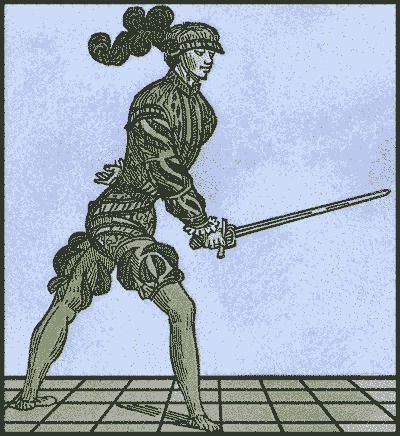
Bolognese fencing is a martial arts system developed in Renaissance Italy. But it's more than that - it's a philosophy about the balance between defense and attack.
What sets Bolognese fencing apart is its emphasis on adaptability. It's not about memorizing moves but understanding the underlying principles that make those moves effective. It doesn't teach you how to fight - it teaches you how to think about the situations you find yourself in in a duel. That's why the manuals written about this system don't just focus on swords - they describe all kinds of weapons and sheilds (e.g. spears, daggers, and capes), and make a point of it to show that the same principles that work with a sword work with any sort of weapon combination.
Your stance is your fortress. The system introduces a bunch of stable stances, or 'guards', and The idea is simple – stay put unless there’s a good reason to move.
Why? Movement makes you vulnerable. When you’re still, you’re a fortress, ready to deflect whatever comes your way. But once you step out of your fortress, you’re no longer safe.
But, to land an attack, you have to move. The trick is to move smart – starting every cut and thrust from a guard and ending in another.
Want to have the upper hand? Get your opponent moving. Kick off a duel with a feint, a move that screams "I’m coming for you!" but is really just a bluff. Your opponent, caught up in the moment, has to react, stepping into vulnerability.
And if they don’t bite, thinking it’s just a bluff? That’s your cue to turn the feint into a full-on attack, catching them off-guard in their moment of doubt.
So, in the dance of Bolognese fencing, it’s all about balancing your moves with strategic stillness, and knowing when to turn a feint into a decisive strike.

Alright, let's get into the legendary "porta di ferro" or "iron door" guard, pictured above. This stance not only looks cool (doesn't it look cool?), it's great because it makes it easy to defend yourself, and it sets you up for some easy counter-attacks. Ready? Here's how you do it:
Each master brought something unique to the table.

You may use the Bolognese techniques with any sort of double-edged, single-handed sword. But the typical sword used in this school is the sidesword, or spada di lato. This type of sword is pictured above.
What distinguishes the sidesword from its counterparts is its versatility. Unlike the heavy longsword, which is specialized for cutting, or the rapier, which is specialized for stabbing, the sidesword does both - it's a "cut and thrust" sword.
The sidesword has features a straight, double-edged blade, narrower and shorter than the longsword but sturdier than the rapier. This design enables fencers to execute swift, precise cuts with ease, while also facilitating precise thrusts aimed at exploiting vulnerabilities in an opponent's defense.
Moreover, the sidesword's hilt has finger rings. This protects the hand and allows for a more controlled grip.
